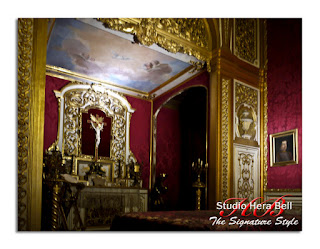Hera had contacted them the week before, and they had invited us to drop by their offices. Florence is a compact city, and their offices were just a short walk away at via dei Banchi 4.
We were warmly greeted by them all, they even opened a bottle of wine for us. They asked us about our trip, and we learned more about each of them, as well as the mysterious Tom Fork.
Today, we were back to our usual routine.
We started with a visit to the ever enjoyable Mercato Centrale to pick up more fresh produce. Including lovely large fresh porcino mushrooms, another bottle of wonderfully full flavoured olive oil, and of course, more cheese.
We visited the Museum of San Marco, which unfortunately closes early most days. Fra Angelico had turned down an offer to become Archbishop of Florence, prefering to remain prior (head monk). But he did not turn down the offer to move the Domincan community from near by Fiesole to the new monastery that Cosimo de' Medici built in1439.
Believing art is a form of prayer, Fra Angelico went about painting the new monastery, creating masterpieces as he decorated. There are several large impressive works, as well a numerous paintings in each cell that the monks lived in. I had always envisioned the cells of monks to be tiny. While these rooms are not large, most are of an adequate size.
Several artists were produced by this community, another famous one was Fra Bartolomeo who worked the generation after Fra Angelico. Fra Bartolomeo also painted another famous resident here, brother Savonarola. When the Medici banks failed a couple of years after Lorenzo the Magnificient's death, Savonarola lead a popular ousting of the Medici family that the town felt was morally and politically bankrupted.
At first Savonarola was warmly greeted, as he made Florence a constitutional republic, shifting power from the Medici's and other wealthy families, giving it back to the people. His sermons were spell binding, as he railed against the corruption of the Church and worldly goods. But politics is a dirty business, and the Medici's re-grouped in Rome, and with the backing of the Church and neighboring powers, Savonarola was undermined. And just like today, the populace is fickle with a short memory. He was hanged, and then burned. We are just as fickle today, but no where as harsh when we vote out the old government. Heads do not roll anymore.
One of the delights of Florence, is to simply walk her streets. Deciding not to head back towards the tourist sites, we simply strolled, and came across a near by square called the Piazza della Annunziata and the Hospital of the Innocents. I sat on the steps, as I looked about the square, while Hera snapped photo after photo. Only a gelato can silence her camera.
Behind the church, is the Museum of the Duomo, and today we decided to tour it. Originally this was the workshop for the artists (including where Michelangelo created his David), it now houses many of the original pieces of the Duomo, as well as the Baptistry doors and sculputres that adorn Giotto's tower.
There are many wonderful pieces of art here, including Michelangelo's last work, without a commission, that he intended as his own monument for his tomb.
Michelangelo sculpted himself in Nicodemus who is lowering the crucified Christ into the waiting arms of Mary Magdalene and his Mother Mary. Seen head on, the three seem to struggle with the body of Jesus. But when viewed from the left, Mother Mary is not seen, and the hood covers Nicodemus' face, leaving just Mary Magdalen lifting her arms to receive Jesus. While when viewed from the right side, Mary Magdalene is hidden, and we see Jesus in the arms of his Mother Mary, with Nicodemus looking down from above.
It is a poweful sculpture, but something provoked Michelangelo to destroy it this unfinished work. Fortunately, the pieces were kepted, and an assistant later put the broken pieces back together.
One work that we were eager to see, doors of the Baptistry, was not available for viewing. Michelangelo had said these doors were fit to be the "Gates of Paradise." The copies on the Baptistry are quite spectacular in itself, and it is a pity that we could not see the real ones. Perhaps we need to return to Florence one day.
Cheers,
Anhony & Hera












































































